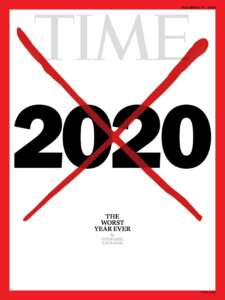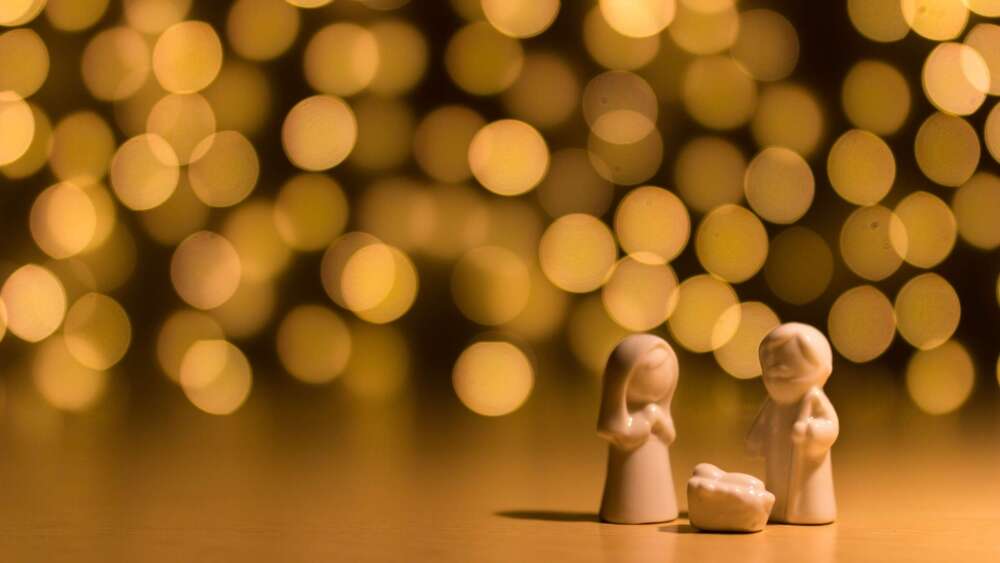Yes, 2020 was a shocker ... but we need hope every year
Words for a weary world – now and always
TIME Magazine’s latest cover image is a large “2020” crossed out with a big red “X.” A bold, symbolic crossing out of 2020 and all its horrors, as the year draws to a close.
 It’s not the first time that TIME has used a X on its cover – there’s been five other occasions. The first was in 1945, to mark the death of Adolf Hitler. The second, later that same year, a black “X” over Japan’s rising sun to mark the end of the war in the Pacific.
It’s not the first time that TIME has used a X on its cover – there’s been five other occasions. The first was in 1945, to mark the death of Adolf Hitler. The second, later that same year, a black “X” over Japan’s rising sun to mark the end of the war in the Pacific.
In 2003 Saddam Hussein was “crossed out” at the beginning of the Iraq war. Next, in 2006, when US forces killed Abu Mousab al-Zarqawi, the leader of al-Qaeda in Iraq, X was used again. And most recently, in 2011, when Osama bin Laden was killed by US special forces.
But if ever there was an entire year that deserved to be crossed out on TIME’s cover, 2020 would be it – with a global pandemic that has killed more than 1.54 million people, destroyed businesses, left so many unemployed, and exacerbated emotional frailties and relational issues as communities “locked down”.
2020 really has been what us Aussies call “a shocker”.
This week, I sat down to write an article about Advent and I started thinking about exactly how awful 2020 has been. I thought how, more than ever, we need the hope that Christmas Day promises. How, more than ever, we need that light drawing us through Advent’s darkness to the birth of a Prince of Peace. More than ever.
More than ever, I find I’m like the boy who cried wolf.
The thing is, if someone was to take everything I have ever written and put it in one of those word cloud images – the ones where the most used words display bigger – I think the phrase “more than ever” would be embarrassingly big.
And I’m not just talking about things I’ve written this year, I’m afraid.
After years of writing communications material, video voice-over scripts and news articles, I have declared “more than ever” more times than anyone ever should in a lifetime.
So, even though I want to write about how we need the “thrill of hope” that draws us forward to Christmas this year, more than ever, I find I’m like the boy who cried wolf. I’ve already declared the hope of Jesus/ change / justice / action /everything is needed more than ever so many times that I can’t stomach reading myself writing it again, even if the timing is perfect.
First, I reacquaint myself with the story of O Holy Night.
Instead, I turn to Google and type in “thrill of hope”, hoping inspiration for a new angle might find me.
First, I reacquaint myself with the story of O Holy Night, the song from which the lyric “a thrill of hope, the weary world rejoices” originates.
It’s a story I love, and I revisit it each year. The year is 1847 in the small southern French town of Roquemaure and the parish priest persuades Placide Cappeau, a local poet, to write a Christmas poem. The story goes that, during a bumpy coach trip to Paris, Cappeau took the gospel of Luke as his guide and imagined witnessing the birth of Jesus in Bethlehem.
By the time he arrived in Paris, “Cantique de Noel” had been completed, and Cappeau was quite inspired. Knowing it was more than a mere poem, he turned to one of his friends, Adolphe Charles Adams, to put the poem to music.
Adolphe was a well-known Jewish classical composer who had studied at the Paris conservatoire. He composed works for orchestras and ballets all over the world. He immediately began to work on his friend’s poem.
Just three weeks later, the song was performed at the church’s midnight mass on Christmas Eve by the opera singer Emily Laurey.
Then, in 1855, Unitarian minister John Sullivan Dwight translated the song into English. It went on to become popular in the United States, particularly with abolitionists in the north.
Googling “a thrill of hope”, I became very aware that the same feelings which make me want to write about us needing the hope of Jesus more than ever this Christmas, have led others to reflect on Cappeau’s lyrics in previous years.
I found a blog from just last year, from a fertility support group, expressing a deep connection with the song’s “weary world” that rejoices at Christ’s birth.
It broke my heart.
“The frenzy of Christmas attempts to cover pain, but the number of stockings hanging over the glowing fireplace can be the constant reminder of a hope unmet,” author Amanda Nicholson wrote.
People have been just as wearily waiting for Jesus, as we all are, for thousands of years.
I also came across an article written in 2018 by Mac McPhail in the Sampson Independent – a local newspaper in Sampson County, North Carolina, USA. Mac identified with the same sense of weariness, and even looked it up.
“It is defined as ‘physically or mentally exhausted; impatient or dissatisfied with something’. That’s a word that seems to describe much of the world we live in today,” Mac wrote.
“Weary from working hard every day and not getting ahead. Weary from … watching politicians in Washington doing little, except make things worse. Weary from dealing with difficult relationships that never seem to improve. Weary from battling sickness, or being the carer for a sick loved one. Weary from living a life that didn’t turn out the way you expected.
“We become discouraged because we wonder if things are ever going to change. But they have changed! Into ‘the weary world’ of Bethlehem two thousand years ago, came ‘a thrill of hope.’ Jesus was born. Jesus, who promises, ‘Come to me, all you who are weary and burdened, and I will give you rest.’ (Matthew 11:28) And that promise is just as true for the weary today.”
Hannah Lunstrum, writing in 2016 for Youth Christ in the Seattle Area, was on my wavelength.
“Now, more than ever, there are so many youth who have never been to church and who know nothing of the hope that Jesus offers. Teen mums who are struggling to make ends meet, who can barely afford to feed their babies, much less provide housing. Youth who are struggling with addictions and mental illness, with no access to support or caring adults. Youth living in low-income, crime ridden neighbourhoods, who struggle to see that there is any future for them besides joining a gang or selling drugs,” she wrote.
I feel you, Han. But again, Cappeau’s poem-turned-song resonated and she wrote, “No matter where we find ourselves though, as followers of Christ, we can find hope in Christmas. I am reminded of a line from one of my favourite Christmas carols, ‘A thrill of hope, the weary world rejoices, for yonder breaks a new and glorious morn.’ (O Holy Night)”
I could, of course, go on with examples from different years unearthed by my internet search, but there’s probably no need. My learning was this: 2020 might have been a shocker of a year for us – a crossed-out magazine cover of a year – but people have been just as wearily waiting for Jesus, as we all are, for thousands of years.
When we experience that longing for him this year – that thrill of hope that draws us through Advent – our feet may feel especially mired in the mud of 2020. But the truth is that human feet have always been mired in something.
The good news? He was there for the weary world on the first Christmas morning, and for those who found themselves weary every year since. And in the same way, he is there for us, the weary ones, who he will cause to rejoice.
Email This Story
Why not send this to a friend?



